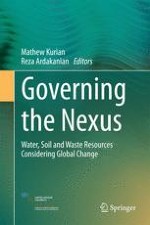2015 | OriginalPaper | Chapter
8. Designing Sustainable Wastewater Reuse Systems: Towards an Agroecology of Wastewater Irrigation
Authors : Philipp Weckenbrock, Graham Alabaster
Published in: Governing the Nexus
Publisher: Springer International Publishing
Activate our intelligent search to find suitable subject content or patents.
Select sections of text to find matching patents with Artificial Intelligence. powered by
Select sections of text to find additional relevant content using AI-assisted search. powered by
